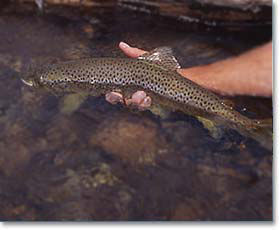
Music to my ears.
Since the creek was narrow enough to jump across, I brought along my trusty Trout Bum Superfine 4-weight to make short casts with ease. I walked the bank downstream until the stream got pretty brushy, but kept going. When I got to an area that looked like it would intimidate most fly fishers, I began fly fishing back upstream to the lodge with a big Parachute Hare’s Ear dry fly. I stopped counting at 30 fish, and this was in only a short hour of fishing. The browns and rainbows ranged from 16 inches to 6 inches, and they eagerly inhaled both the dry fly and a Tunghead Pheasant Tail nymph. It was some of the best fly fishing I’ve had in years—within spitting distance of a lodge that hosts scores of good fishermen in a weekend even the tiny fish put a good bend in the Superfine rod. I never would have been able to fish that little creek with the powerful 9-foot, 5-weight Frequent Flyer rod I used on the Madison an hour earlier. I would have been hanging up in the streamside brush. The Superfine rod is the perfect rod for such tight quarters. It's built to load well on those 10 to 15-foot casts in a way that bigger, stiffer fly rods simply can’t. I caught more fish because I had the trusty Trout Bum.
Feeder streams to famous trout rivers usually get ignored. They look too small to hold decent fish, or they look too tight for an overhead cast. But these tiny streams sometimes host large trout that leave the bigger waters because of high water temperatures or heavy boat traffic. Feeder streams always offer cooler water than main rivers, and food is not as abundant as on the big riffles of larger rivers. So you get trout that have not been educated, that eat all day long, and are eager to smash any fly that looks edible.
Here are some tips for fly fishing feeder streams the next time a famous trout stream lets you down:
- Ignore the junction of a feeder with the main river for a few hundred feet. Everybody fishes there.
- Walk upstream from the main river until the casting begins to look difficult. Or if you are on a road well upstream from the main river, walk up or down until you get out of sight of any bridges
- Don’t walk the banks. Stay well away from the water—get to a point where you can’t see the water—and them move upstream or down before fishing. Trout in feeder streams may not be the sharpest tools in the shed, but they are spooky!
- Fishing upstream is almost always better, because you can approach the fish without spooking them. If you want to fish a stretch downstream of your position, walk downstream (stay away from the bank!) and then work up.
- Leave your tiny flies and light tippets on the main river. These fish are looking for a big mouthful, and they feed on terrestrials more often than mayflies and caddisflies. A heavier tippet allows you to rip your fly out of a tree without disturbing the water, and fish on feeder streams are seldom leader shy unless they are in flat, still pools.
- A big dry fly with wings you can see is usually the best fly. Parachute Adams, Parachute Hare’s Ear, Royal Wulffs, Stimulators, Humpies, or grasshopper patterns are some of the best flies, from Maine to California.
- For an even better bet, tie 10 inches of 4X or 5X tippet to the bend of your dry fly hook and add a size 12 Hare’s Ear Nymph. The dry fly then becomes your strike indicator and you’ll probably double your strikes.
- Be stealthy but move quickly. If a trout in a feeder stream does not take on the first or second cast, it is probably spooked and no amount of repeated fly casting will get it to rise.
- Keep your profile low. Crouch when moving and kneel when casting your flies.
- Your fly rod needs to load quickly. Superfine fly rods are your best choice, but if you have to you can overline a stiffer, faster fly rod by one or two line sizes to get the fly rod to work with only 10 feet of line out. It’s not as effective as a Superfine fly rod, nor nearly as pleasurable, but it will get the job done.
- A shorter leader generates higher fly line speed to fire your fly into brushy areas. Use a 6-foot or 7 ½-foot leader for feeder stream fly fishing.




